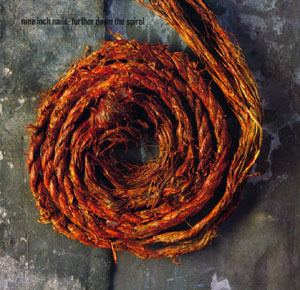Recorded 1994–95 Further Down the Spiral(1995) The Fragile(1999) | Length 63:5668:59 (V2) "Halo 10"(1995) "Halo 11"(1997) Release date 1 June 1995 | |
 | ||
Released June 1, 1995 (1995-06-01) Genres Industrial music, Industrial rock, Electronica, Post-industrial music Similar Nine Inch Nails albums, Industrial music albums | ||
Further Down the Spiral is the first remix album by American industrial rock album Nine Inch Nails, released on June 1, 1995. It is the companion remix disc to The Downward Spiral. The album contains two editions, one denoted as Halo 10 (released in the United States and in the United Kingdom on the morning of release, to be pulled and replaced with Halo 10 V2 by lunch time) the other as Halo 10 V2 (released in Japan, Australia, and the UK), each containing a different set of tracks with a large degree of overlap between the two.
Contents
- nine inch nails piggy nothing can stop me now
- At the Heart of It All and The Beauty of Being Numb
- Coil on Reznors remix files
- Charlie Clouser on his process
- Songs
- References
The album was certified gold by the Recording Industry Association of America (RIAA) on June 26, 1996, denoting sales in excess of 500,000 copies in the US. Further Down the Spiral showed a more varied and experimental point of view to the original and boasted many high-profile remixers and contributors including Aphex Twin, J. G. Thirlwell, Rick Rubin with Dave Navarro and Coil with Danny Hyde.
The discs include remixes of "Mr. Self Destruct", "Piggy", "Hurt", "Eraser", "The Downward Spiral", "Heresy", "Reptile", and "Ruiner" as well as two original compositions by Aphex Twin.
Coil contributed more remixes than any of the other participating artists with a total of four tracks—"The Downward Spiral (The Bottom)", "Eraser (Denial; Realization)", "Eraser (Polite)", and "Erased, Over, Out". J. G. Thirlwell is the second-most featured artist with three contributions - "Self Destruction, Part Two", "Self Destruction, Part Three", and "Self Destruction, Final".
nine inch nails piggy nothing can stop me now
"At the Heart of It All" and "The Beauty of Being Numb"
Aphex Twin's two contributions to Further Down the Spiral are not remixes but rather new works using samples from the originals composed specifically for the album. Aphex Twin is the performance moniker of British electronic musician Richard D. James, who was quoted about his various "remixes" as saying "I never heard the originals, I still haven't. I don't want to either, or my remixes for that matter." Both tracks would later appear in shortened form on Aphex Twin's 2003 compilation 26 Mixes for Cash. "At the Heart of It All" shares its name with a Coil piece from their 1984 LP Scatology.
Coil on Reznor's remix files
In an interview from 1998, Coil describe the manner in which Reznor prepared the multitracks:
John Balance:
"It's good to get something Trent will send you because he'll send you a really precise, clean, good sounding master tape where you can take all the sections out and you can re arrange it totally. You get spoiled because such a good clean master comes to you, and you can say "Wow!" and rip it to shreds and do whatever you want."
Peter Christopherson:
"I think though, the last things we did for him, we actually got Studio-Vision discs, with everything already laid out. He is very organized by the way."
Charlie Clouser on his process
In posts on the Gearslutz forum, former NIN member Charlie Clouser described how he put his contributions together:
"Heresy remix = Studiovision triggering 2x NuBus Samplecell-1 8mb cards and 4 audio tracks of Protools-16. 1 track lead vox, 2 tracks gtr fx, 1 track for preachers and misc. Yes, 4 tracks of audio. First SampleCell loaded with drums and stuff, second one loaded with chopped gtr riffs. 8 megs each.
No Xpander. Bit-crushed "pox" arpeggios and distant descending melody from Emax SEHD rack with modwheel filter control. All guitars chopped into riffs and put in samplecells then retriggered from keyboard. Wild pitch fx on guitars by HyperPrism standalone (no plugins in those days). Backwards vocal fx by... it's a secret. Outboard filtering on guitars by Arp Solus via MPU-101 and maybe Peavey Spectrum Filter. Lead vox flattened with L1 offline in SD2 (again, no plugins in DAWs back then).
Mixed on Mackie 32x8 with no compressors or outboard eq. Send fx (incl. vox verb and delay) from QuadraVerb+ and maybe DP4. The phasey sound on guitars is either DP4 or else it's just an artifact of the HyperPrism pitch fx. Yes, Alesis Quadraverb and a Mackie 8-buss.
"Ruiner" remix? That had a sine-wave portamento sound that was actually "Init Voice" on the original DX-7 put through Arp Solus filter for gating fx. ... I loved that "Init Voice" patch. I wonder who programmed it?".
Songs
1Piggy (Nothing Can Stop Me Now)4:03
2The Art of Self Destruction - Part One5:42
3Self Destruction - Part Three3:29
